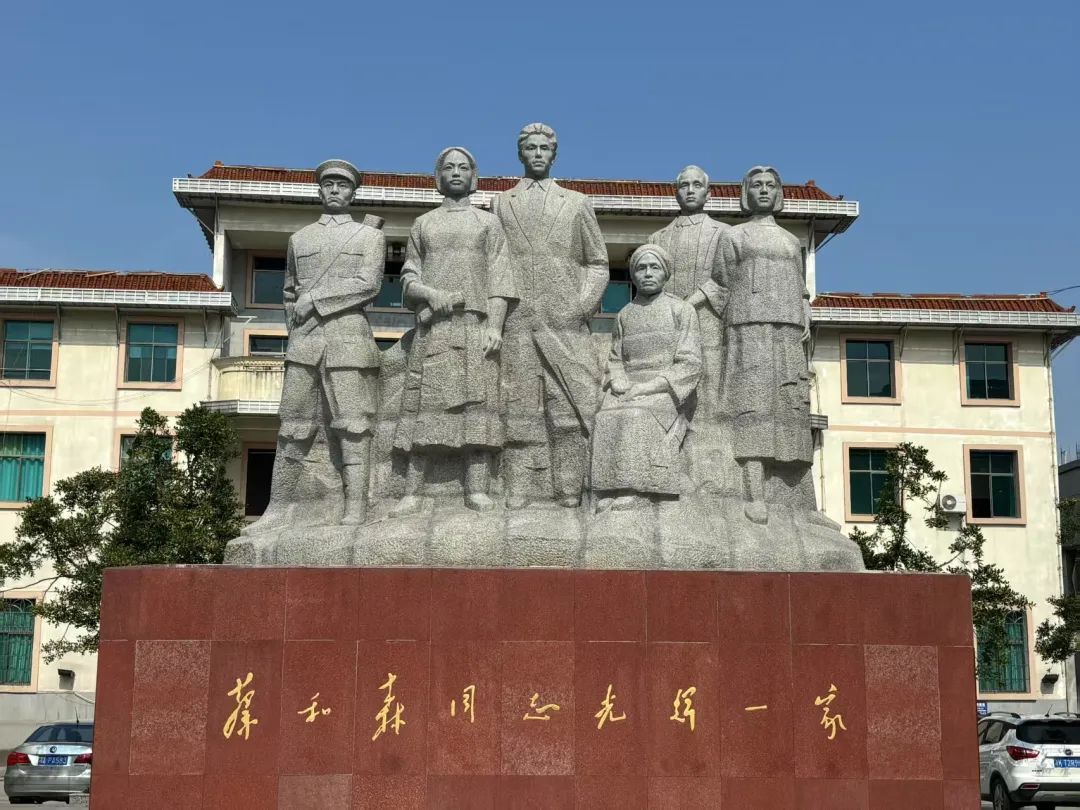Cai Hesen Memorial Hall
The Cai Hesen Memorial Hall is located at No. 247 Fuxing Street, Yongfeng Subdistrict, Shuangfeng County, Loudi City, Hunan Province. It officially opened to the public in April 1988, coinciding with the 70th anniversary of the founding of the Xinmin Society. The memorial hall is a national patriotism education demonstration base, a national AAAA-level tourist attraction, a national third-grade museum, and a national women's patriotism education base. The scenic area covers an area of 20,000 square meters, with a total construction area of over 3,000 square meters, and the exhibition hall area of the memorial hall is 1,000 square meters. Above the main entrance is the name of the museum inscribed by Marshal Nie Rongzhen. In the center of Cai Hesen Square in front of the museum stands a group sculpture titled "The Glorious Family of Comrade Cai Hesen." Exhibition Halls 1-4 feature displays on the life and achievements of Comrade Cai Hesen, while Exhibition Halls 5-6 house exhibits on the life of Comrade Cai Chang. Utilizing a variety of display methods, including original scene restorations, electronic light sand tables, oil paintings and traditional Chinese paintings, figure sculptures, multimedia presentations, and cultural relic displays, the memorial hall comprehensively and systematically showcases the glorious life journeys of Comrades Cai Hesen and Cai Chang, from their diligent studies in their youth to their lifelong struggles for the Chinese revolution.

The Glorious Family of Comrade Cai Hesen
"The Glorious Family" Group Sculpture
At the center of Cai Hesen Square stands a group sculpture titled "The Glorious Family of Comrade Cai Hesen," which vividly recreates the historical scene of Cai Hesen's family dedicating themselves to the revolution and embodies the red family tradition of "six outstanding members from one family."
From left to right, the statues depict: Cai Linzheng (originally named Cai Luxian, Cai Hesen's third elder brother), Xiang Jingyu (Cai Hesen's wife), Cai Hesen, Ge Jianhao (Cai Hesen's mother), Li Fuchun (Cai Chang's husband), and Cai Chang (Cai Hesen's younger sister).
Historical Exhibits
Immersive experiences in six themed exhibition halls:
The first and second floors feature the exhibition "Cai Hesen: An Outstanding Early Leader of the Communist Party of China," divided into five sections: Leading the Whole Family into the Revolution, Pioneer of Party Theory, Dedication to the Kuomintang-Communist Cooperation, Struggles at Critical Moments of the Revolution, and Forever Remembered by the People.
The third floor houses the "Cai Chang Exhibition Room," with the exhibition title inscribed by Li Xiannian. It is divided into four sections: Following Her Brother into the Revolution, Shouldering the Cause of Women's Liberation, Pioneer of the International Women's Movement, and Sincere Adoration and Deep Remembrance. The exhibition hall displays cultural relics, artifacts, photographs, and works of Comrades Cai Hesen and Cai Chang from their youthful diligent studies to their lifelong struggles for the Chinese revolution. It also includes inscriptions by Party and state leaders such as Deng Xiaoping, Chen Yun, and Nie Rongzhen in memory of Cai Hesen, as well as poems by cultural figures such as Zhou Shizhao, Liu Yazi, Mao Dun, and Luo Zhanglong expressing their remembrance of Cai Hesen.
Special Exhibition: "Revolution in Family Letters"
This exhibition displays original letters (replicas) exchanged between Cai Hesen and Xiang Jingyu, such as the content from "A Letter to Jingyu" in 1923, which reads, "Strive to be a person who transforms society," showcasing the ideals and love of the revolutionary couple.
Cai Chang Exhibition Room
To commemorate the 100th anniversary of Cai Chang's birth, the Cai Chang Exhibition Room was added to the Cai Hesen Memorial Hall. It is a unique feature of the memorial hall to commemorate two revolutionaries simultaneously.
Cai Chang, born on May 14, 1900, in Guangjia Hall, Yangqiu Village, Jingzi Town, Shuangfeng County, was a beloved proletarian revolutionary of the older generation by the Party and the people. She held leading positions in the Party and state for a long time, serving as a member of the Standing Committees of the First, Second, and Third National People's Congresses, Vice Chairperson of the Fourth and Fifth National People's Congresses, and a member of the Central Committees of the Seventh, Eighth, Ninth, Tenth, and Eleventh National Congresses of the Communist Party of China. She dedicated her entire life to the liberation of the Chinese people and the cause of socialist construction.

